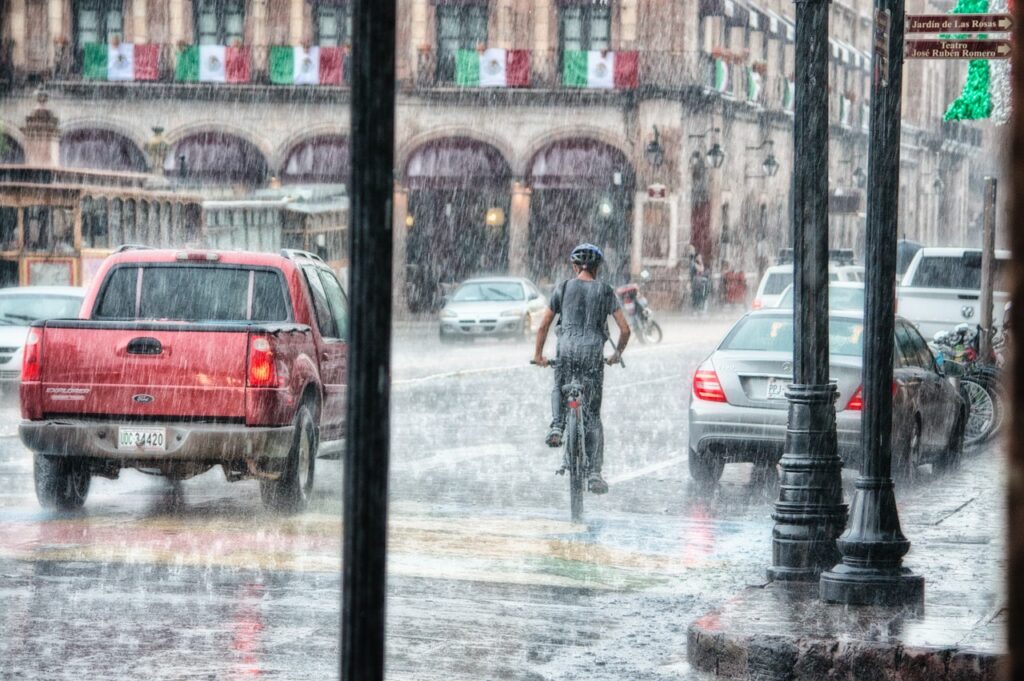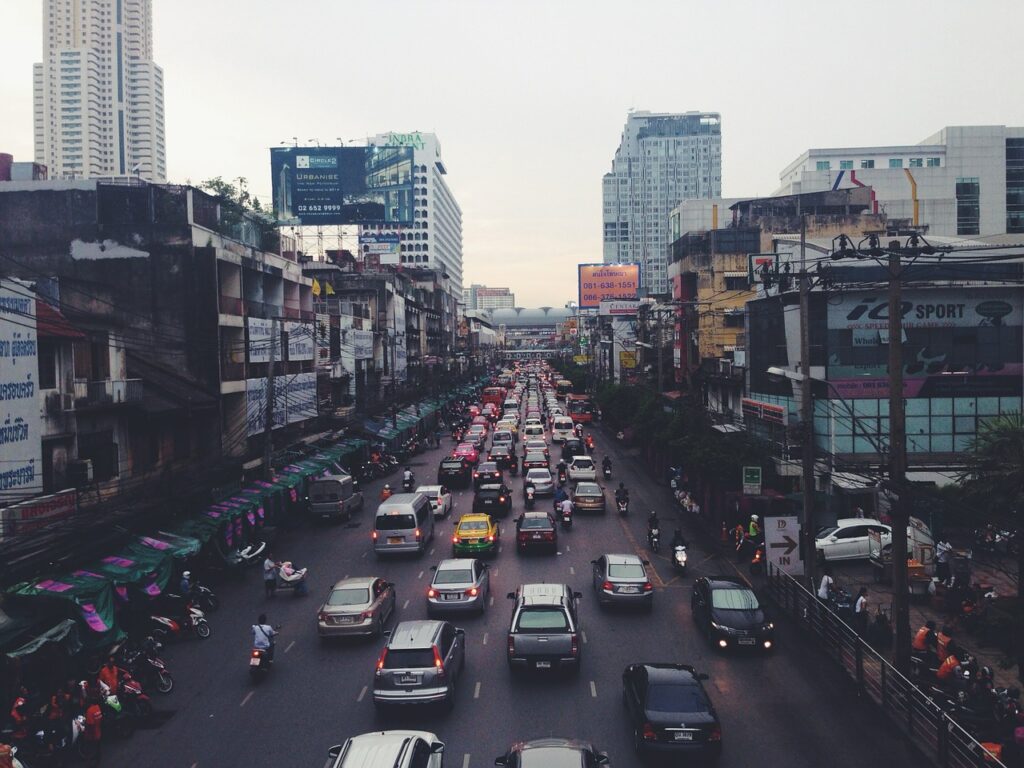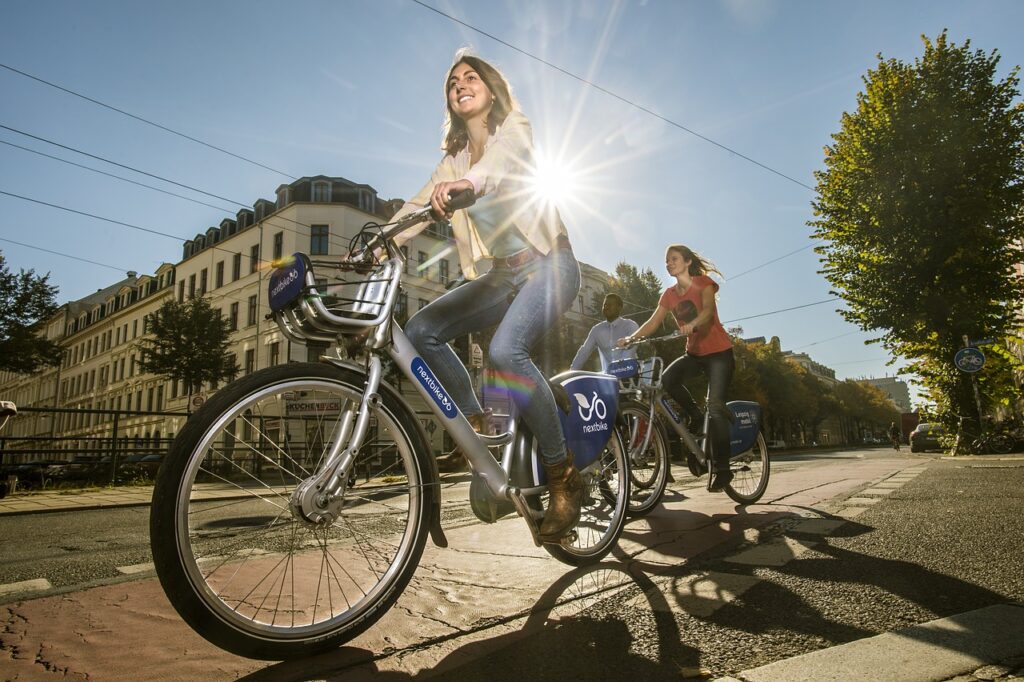Bike commuting seems like an ideal way to commute within the city. Who doesn’t like working out and commuting at the same time? Plus, it helps save our Mother Earth. But, I believe you know the inherent problems of bike commuting.
These problems make people avoid bike commuting. Some even hate it because of them.
I have a quest for you. Whenever you are driving, try to count the number of cyclists on the road.
If there are many cyclists, then it’s awesome. Your country is doing a great job. However, if you barely see any cyclists, welcome to the real world, then.
Sadly, these inherent problems of bike commuting have been rooting in our daily lives. And that’s the purpose I wanna discuss this.
Precisely, let’s discuss the real challenges and improvements of bike commuting.
After all, we wanna solve the problems so that we can make bike commuting be our routine and a future trend.
1. Challenges
1.1 Dirt and sweat
Cycling is a great workout. You exercise while riding to work. You are full of energy and you are ready to work!
But, the moment you enter the office, you colleagues throw you a weird look. Confusing, you scan your body from the top to the bottom. And then you know why.
Not only do you sweat profusely, but you are also dirty with mud. Oh yeah, you recall where you rode on a muddy track and road. That’s why.
“I seriously need a shower” said in your mind. But the truth is, you CAN’T because there is no shower room in the office!
You have no choice but to stay like this for the rest of the day. Not to forget to mention that you smell terrible. – Clumsy AF.
Ironically, you wonder why shower room is not available where it is common at the gym.
Nonetheless, you remember how it feels and you don’t want this to happen again, for sure. Well, you stop bike commuting from that day onwards.
1.2 Weather

While driving to work, there is pouring rain suddenly. As moving slowly in the traffic, you notice a few motorcyclists and cyclists stopping by the shelter, waiting for the rain to stop.
You secretly laugh at them because they “truly” deserve this. That’s why you hate bike commuting so much……
Many bikers don’t bring rain jackets when cycling although they know they need them when raining. So, they can’t ride unless the rain stops.
Even if they bring rain jackets, this doesn’t help much either. Why? It’s extremely dangerous to ride under the rain. The road is obviously not for wet cycling, because it is so slippery.
Or, the temperature is either too warm or too cold, that makes bike commuting hostile.
And cycling for heath? Not quite. While the air pollution of some countries is so freaking terrible, literally you suck the smoke into your lungs when cycling. – It defeats the purpose.
1.3 Lacks bike infrastructure
Sometimes, commuting by bike is like having a war. That’s the challenge that every cyclist has to face.
First challenge is there’s no bike lane. Well, they have to use the road and share with other drivers. It makes cycling intense.
When reaching the office or school, another challenge awaits. There’s no bike rack or pole to park their bikes. It’s beyond common sense.
It’s both frustrating and ridiculous. Well, cyclists are also taxpayers. They pay taxes and the government should use the money to improve infrastructure.
While they use the money for road facilities, they always overlook bike infrastructure. C’mon. That is really absurd. Why can’t they be considerate to take care of the welfare of cyclists, too?
It’s sad because this happens around the world. Thank to this, certain cities are extremely biking unfriendly.
You can only see expressways, roads all over the places. And yet, you can’t even spot a single bike lane. While the traffic is so busy, nobody dares to cycle in this hectic environment.
Apart from public transportation, this is in favour of driving. This makes traffic jam even worse and it forms a vicious cycle.
1.4 Safety

It’s a general conception where a car is always safer than a motorbike or a bike.
Hence, many people believe that bike commuting is less safe because of this. Numbers don’t lie. We can check the accidents for bike.
Statistics of cyclist death in the US shows that 843 cyclists were killed in crashes with motor vehicles in 2019.
Although the deaths declines since 1975, the death among cyclists older than 20 has increased. More male than female cyclists were killed.
Accidents happen always. However, improper bike infrastructure could be one of the reasons.
There could be no bike lane at all. So, cyclists have to use the road and share with drivers. Even when there are bike lanes, joint bike lanes seem not as safe as they are.
There was a study on cyclists’ injuries and the cycling environment. The researchers found that:
- Separated / protected bike lanes, off-street bike paths, etc are the safest
- Street with no bike lanes, sharrows, or bike lanes between parked and moving cars, etc are the least safe.
This study is surprising but also sensible. We mostly see bike lanes merged with roads. We see the effort, but it seems not reducing the risk of cycling.
That’s why accidents happen. And people blame on bike commuting……
1.5 Vague traffic rules
Regardless who we are, road users must follow traffic rules. Based on this notion, cyclists should also follow traffic rules when they ride on the road.
Seems like this is clear and concise. No confusion. So, it shouldn’t be a problem, right? Well, hang on, if this is your thought.
However, some of the traffic rules are actually vague. Further to the problems above, these vague traffic rules seems not helping bike commuting, either.
This forms a grey area that may confuse cyclists. So, let’s look at some unclear traffic rules:
Speed limit
Ok, we need to observe speed limit. But, it doesn’t spell out whether cyclists need to follow speed limit or not. Meaning, it remains silent.
This gives a big question mark to cyclists whether they have to follow legally or not. And guess what? Some may even take advantage of it and assume they don’t need to follow this…..
Well, we presume cyclists need to follow speed limit. But next issue arises. Let me show you.
Let’s assume the speed limit is 60km/h. Well, for cars or trucks, that limit is reasonable. But, 60km/h for cycling, don’t you think this is too fast?
If cyclists ride 60km/h, legally they are right. But, it is terribly dangerous, not only for themselves, but for other road users, too.
Simply said, there is no speed limit wholly for cycling.
Helmet

Cycling is similar to motorcycling, because both vehicles only have 2 wheels. Common sense will tell us that the rules for motorcycling are also applied for cycling.
There you are. Motorcyclists MUST wear helmets. That’s to reduce risk of injury in case where accidents happen. If we follow this logic, cyclists must wear helmet, too!
Ironically, that’s not the case. To date, there are only 3 countries mandate helmets for cycling, ie. Australia, New Zealand, and Argentina.
Plus, mandating helmets for cycling is not straight forward. The author of this article is of the opinion where helmet should be voluntary for cycling. By the way, he is a Senior Director of Advocacy at Transportation Alternative.
He argues that enforcing the law can actually make cyclists vulnerable on the road, given the ridership will drop. And this will reduce “Safety In Numbers” effect.
Indeed, his argument is interesting. But, you will also notice there is strong debate in the comment session. Thus, it truly reflects the aggressive debates on mandating helmet for cycling around the world.
Nonetheless, his argument reveals the ugly behaviour of some cyclists. They seem not to care about their safety when riding on the road.
Rather, they prefer convenience over safety. And they might think wearing a helmet is a threat. – SMH.
Fine system
Many countries are adopting automated speed traps to catch law breakers. To hold the drivers liable, usual evidence is to identify number plates.
This creates a great loophole for cycling. What if cyclists break the speed limit? How are they being caught?
Even when policemen / traffic officers issue tickets to cyclists, are there any standard documents to rely on? – Eg identification cards or car licenses.
And, are the tickets valid? What if the cyclists didn’t settle the ticket, how were they held liable?
Minimal age requirement
So, we need to learn how to drive or ride a motorbike. Then we need to have a test before we get a driving license.
And since there’s a minimal age to get the test, that’s the minimal age requirement to drive or ride a motorbike. – It’s clear, and it’s under the law.
This gets really confusing for cycling. The truth is, we don’t need a license to ride a bike. And a critical issue arises.
What is the minimal legal age to ride on the road?
Honestly, I couldn’t tell. Don’t think this is mundane, because it is crucial for legal aspect.
Things get complex when an UNDERAGE cyclist causes a road accident. Most countries exempt underage children from criminal acts.
So, the minimal age sets the basic defense to forbid underage children riding on the road. Otherwise, they might not be held liable for the act, if they cause accidents.
This, however, is just a general concern. Some countries may have this requirement, depending on the jurisdiction.
Bike lanes not compulsory
Once in a while, you see a cyclist riding on the middle of the road, instead of the bike lane next to it, while driving.
You are furious because you can’t stand those who break the rule. And you want to yet at them so badly to get back to the bike lane.
Well, it turns out that you might be wrong. And they might not break the rule. Is it surprising?
Depending on the system, cyclists riding on bike lanes might not be compulsory. They have the right to “choose” whether to ride on the road or the bike lane.
The UK is a good example. With reference to The Highway Code for Cyclist Section 63, although cycling on bike lanes is encouraged, it is not mandatory.
Perhaps cyclists might need to diverge from the bike lanes to save themselves. As you know, sometimes there are obstacles on the bike lanes. The cyclists can hit the obstacles and fall down if riding on the bike lanes.
Despite that, some cyclists might abuse the flexibility given to them. Since it is not mandatory, they can easily switch the lanes as they want. As a result, they might cause danger to other road users.
1.6 General perception
People are OK with bike commuting so long the cyclists follow the traffic rules. Nonetheless, some of them hate cyclists so much. They see the cyclists as the 2nd class road users.
Roads are for drivers, not cyclists.
They break traffic rules. They ride small vehicles that are so slow and occupy the whole lane. Meaning, they block and slow the traffic down.
Or, people are jealous of cyclists, perhaps. They don’t have to suffer in traffic jam.
So, some people are being rude and vulgar to the cyclists. These people, better called road rages, insult, honk, and overtake the cyclists very close with fast speed.
Even some of them are not, they might not respect bike infrastructure. That’s why we can see drivers parking their cars on bike lanes. And when cyclists diverge from bike lanes because of this, they might get tickets. – And we can see why bike commuters struggle with this.
Or, bike racks or bike poles are always the target of vandalism……
1.7 Automotive industry
Traffic problem is a global issue, which every country wishes to solve. To make it worse, it is a factor to cause air pollution.
So, politicians promise to come out with innovative solutions to combat these issues.
Regardless of what solutions they have, they hardly sacrifice automotive production. In other words, they will be getting more cars on the roads. – Do you think this can solve the root problems?
And it is all because of MONEY. You see. Automotive industry is a major contributor to Gross Domestic Product (GDP). – Measure of economic growth.
And automotive industry is crucial for other areas as well. These include:
- Job opportunities
- Supply chain
- Research and development
- Taxes and duties
- Foreign direct investment (FDI)
- Oil and gas
In other words, cutting automotive production means shrinking the industry. And this creates negative chain reaction to the areas above. – In the end, less money to the country.
Do you think countries will forgo this lucrative industry? Plus, promoting bike commuting needs money and takes time. Do you think they will “waste” their time and money on this?
With the growth of motor vehicles demand, bike commuting becomes more hostile. Hence, it further discourages people riding on the road.
2. Improvements
Despite the problems that bike commuting is facing, I still stand on the ground where bike commuting should be a future trend.
To make it more friendly, it’s time to make some changes for bike commuting.
2.1 Make traffic rules clear
It’s great to see general traffic rules hold cyclists liable to some extent. But, they are still not clear yet and it creates some grey area for abuse.
Spell out the traffic rules for cycling. Be crystal clear.
The rules in Vague Traffic Rules Section are what I observe. Authorities can look at certain areas that need improvement.
Our purpose is simple. We need to hold all road users accountable. Be they pedestrians, drivers, cyclists, or motorcyclist.
After all, cyclists no longer have the mindset where they are exempt from obeying traffic rules.
2.2 Minister / mayor sets example

In corporate world, we need leader to lead by example. This helps set the tone and culture for the rest to follow.
The exact same principle can be applied here!
First, minister or mayor should put in effort to advocate bike commuting. Not only this, they can set an example to start riding to work.
There is no point where they promote bike commuting, yet they themselves don’t ride a bike. Residents will not be convinced.
Netherlands is a perfect example. The Prime Minister, Mark Rutte, loves riding a bike to work every day. Interestingly, Netherlands has the most bikes per capita, the highest in the world.
We can see the Prime Minister blends with the culture so well. While setting an example, I can see why the Dutch really loves cycling.
2.3 Proper urban planning
With that being said, cycling will never dominate in this driving-dominant era. – At least for now.
But, it doesn’t mean we can’t create a bike friendly environment.
Adding more bike lanes and bike racks is a good start, but I believe the government can do better than this.
Similar to road network system, we need a thorough bike network system. A system that is not only moving from Point A to Point B, but to move everywhere safely.
Apart from this, we need PROTECTED bike lanes and sufficient bike racks or poles.
Keep joint bike lanes minimal. ‘Cuz they still impose safety risk to cyclists. This is in line with the study above.
Ok, they may argue that having a proper planning for bike infrastructure is not feasible, especially where the cities don’t have enough space.
Here’s a thing. Road network system and metro / subway system are much more complicated than this. Since engineers can solve these, I believe they can do this for bike network system.
It is a matter of intention to do this. Not the inherent difficulty.
2.4 Shower rooms in the office
This should be the first change for bike commuting.
I would assume there’s no shower room in most office buildings. But, it’s not a problem.
The management can easily renovate their bathrooms. They just need at least 1 shower room in each bathroom. – And I don’t think this is not feasible.
Trust me. This is one of the main problems where people avoid bike commuting. They want to be clean, too.
I’m sure they love having a shower after the sweaty and dirty ride.
Final thought: bike commuting problems
We can’t deny that the problems of bike commuting bother us for a long time. When looking at these challenges, we know it’s tough to transform to a bike-friendly society.
Everybody saw these. No shower rooms, vague traffic rules, lacks bike infrastructure, being rude to cyclists, etc. These factors make bike commuting hostile.
However, it doesn’t mean we should compromise and refuse to make a change.
A change is tough, but it is necessary. A change that requires everyone to kick start. It takes time and huge effort.
But, as time goes by, I’m sure people perception on cycling will change. It will alter the driving-dominant culture and start making a bike-friendly culture.
Relevant posts
